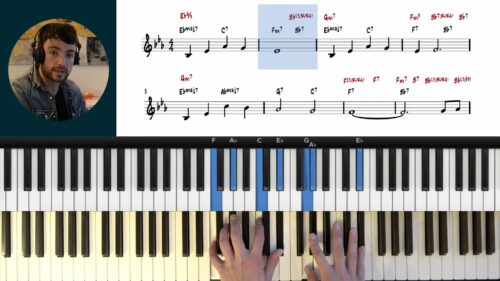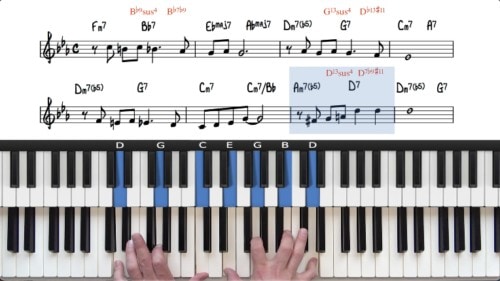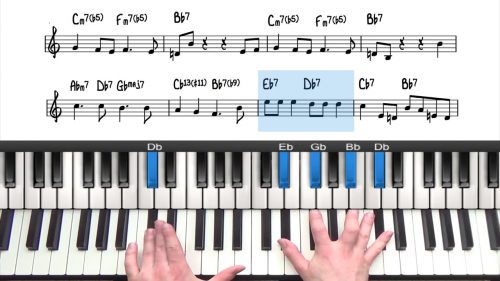Suspended Chords for Fills – ‘Body & Soul’
In this lesson we explore different fill techniques using suspended chords to create movement and harmonic interest in the tune ‘Body & Soul’.
Fills are most effective when placed in gaps where the harmony and/or melody are static, allowing for tasteful embellishments that enhance the harmony without overpowering the song’s theme and melody.
By the end of this lesson you’ll be able to seamlessly integrate suspended chords, chord alterations, and rootless voicings to develop harmonically-sophisticated jazz fills.
Identifying Fill Opportunities
The first step in adding fills is identifying where the melody rests. In ‘Body & Soul’, a significant gap occurs over the Eb-7 → Ab7 → Dbmaj7 progression (a 2-5-1 in Db major). This provides the perfect space for harmonic embellishments.
Basic vs. Extended Voicings
We first recap the voicing options that we have for the 2-5-1 progression in Db Major:
- Eb-7 → Ab7 → Dbmaj7 (basic voicings)
- Eb-9 → Ab13 → Dbmaj7 (extended voicings)
It’s important to notice that even with extensions present, the core voice leading remains the same—7ths resolve to 3rds, creating smooth chord transitions.
Using Sus Chords for Movement
A powerful trick when playing jazz ballads is substituting the ii-7 chord with a V7sus chord by placing the V7 root in the bass under the ii-7 chord’s rootless voicing.
For example:
Instead of Eb-9 → Ab13 → Dbmaj7, we play Ab13sus instead of Eb-9
Then resolve to Ab7alt → Dbmaj7
This technique maintains the same voicing structure while creating a suspended, unresolved sound before resolving into the tonic.
Adding Chromatic Motion
We can enhance this progression by moving notes chromatically within the sus chord:
-
Ab13sus → Ab7(b9, #5) → Dbmaj7(6/9)
- Drop the 9th & 13th of Ab13sus down chromatically to a b9 and #5
Here we lower all three top notes to create tension with alterations and then a strong resolution. This descending motion is a very useful sequence and it should be learnt in all 12 keys.
Melodic Embellishments & Rhythmic Variations
Aside from harmonic movement, rhythmic placement adds variety to fills:
-
Rolling Notes – Breaking up the voicing with a slight roll can create a smoother transition into the next chord.
-
Doubling Notes – Repeating melody notes or playing block chords in rhythmic bursts adds texture and fills out the space.
- Timing & Feel – With this laid-back phrasing, we push and pull the timing for a more conversational style.
Practice Tips
-
Identify Gaps in the Melody – Choose spots where fills can naturally fit without overpowering the tune.
-
Experiment with Sus Chords – Substitute the ii-7 chord into a Vsus13 chord for interesting harmonic movement.
-
Play in the Right Register – Rootless voicings sound best in the mid-range to avoid muddiness.
- Develop a Flexible Approach – Mix full, expansive chordal fills with more delicate single-note embellishments for contrast.






